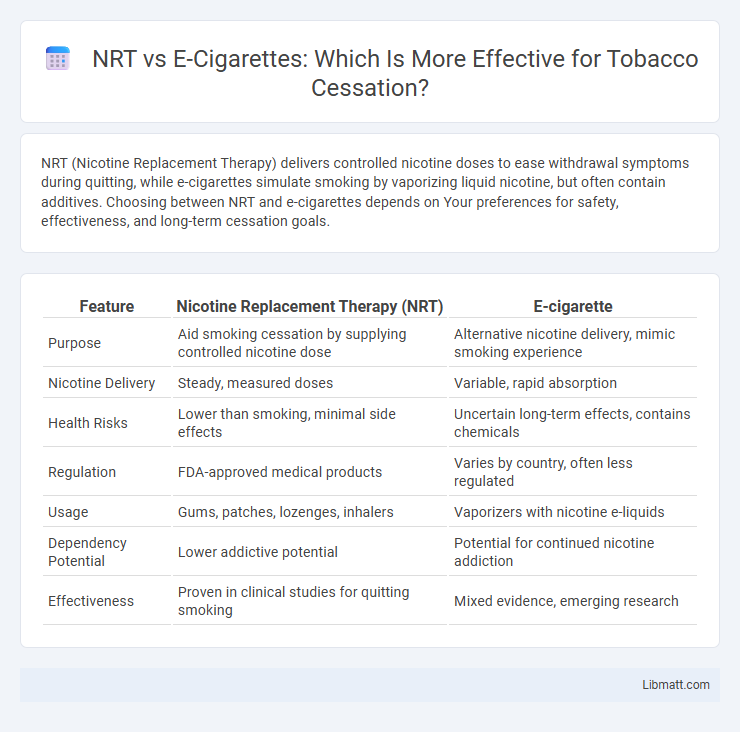NRT (Nicotine Replacement Therapy) delivers controlled nicotine doses to ease withdrawal symptoms during quitting, while e-cigarettes simulate smoking by vaporizing liquid nicotine, but often contain additives. Choosing between NRT and e-cigarettes depends on Your preferences for safety, effectiveness, and long-term cessation goals.
Table of Comparison
| Feature | Nicotine Replacement Therapy (NRT) | E-cigarette |
|---|---|---|
| Purpose | Aid smoking cessation by supplying controlled nicotine dose | Alternative nicotine delivery, mimic smoking experience |
| Nicotine Delivery | Steady, measured doses | Variable, rapid absorption |
| Health Risks | Lower than smoking, minimal side effects | Uncertain long-term effects, contains chemicals |
| Regulation | FDA-approved medical products | Varies by country, often less regulated |
| Usage | Gums, patches, lozenges, inhalers | Vaporizers with nicotine e-liquids |
| Dependency Potential | Lower addictive potential | Potential for continued nicotine addiction |
| Effectiveness | Proven in clinical studies for quitting smoking | Mixed evidence, emerging research |
Introduction to NRT and E-Cigarettes
Nicotine Replacement Therapy (NRT) includes products like patches, gums, and lozenges designed to deliver controlled nicotine doses to reduce withdrawal symptoms during smoking cessation. E-cigarettes, or electronic nicotine delivery systems (ENDS), vaporize a liquid containing nicotine and flavorings, simulating the smoking experience without combustion. Both methods aim to help smokers quit but differ in delivery mechanisms and regulatory status.
Understanding Nicotine Replacement Therapy (NRT)
Nicotine Replacement Therapy (NRT) delivers controlled doses of nicotine to reduce withdrawal symptoms and cravings for smokers aiming to quit, using products such as patches, gum, lozenges, inhalers, and nasal sprays. Unlike e-cigarettes that vaporize liquid containing nicotine and other chemicals, NRT provides a medically approved, smoke-free alternative with fewer harmful substances. Clinical studies demonstrate that NRT increases quit rates by approximately 50-60%, making it a reliable tool in smoking cessation programs.
What Are E-Cigarettes?
E-cigarettes are battery-operated devices that heat a liquid solution to produce an aerosol, often called vapor, which users inhale. This liquid typically contains nicotine, flavorings, and other chemicals, providing a similar sensation to smoking traditional cigarettes without burning tobacco. Unlike nicotine replacement therapy (NRT) products, e-cigarettes mimic the behavioral aspects of smoking but lack standardized dosing, raising concerns over safety and long-term health effects.
How NRT Works: Mechanisms and Benefits
Nicotine Replacement Therapy (NRT) delivers controlled doses of nicotine to reduce withdrawal symptoms and cravings by stimulating nicotinic acetylcholine receptors in the brain without harmful tobacco combustion products. This mechanism helps stabilize dopamine levels, aiding mood regulation and decreasing dependence on cigarettes. Clinical evidence shows NRT increases smoking cessation success rates by approximately 50-70% compared to placebo, enhancing long-term quit outcomes.
How E-Cigarettes Work: Technology and Trends
E-cigarettes function by heating a liquid solution, usually containing nicotine, flavorings, and other chemicals, into an aerosol inhaled by the user, utilizing advanced battery-powered heating elements. Recent trends highlight the incorporation of temperature control technology and customizable features, enhancing user experience and nicotine delivery precision. Innovations in e-cigarette devices increasingly target harm reduction and convenience compared to traditional Nicotine Replacement Therapy (NRT) methods.
Effectiveness of NRT vs. E-Cigarettes for Quitting Smoking
Nicotine Replacement Therapy (NRT) has proven efficacy with higher quit rates compared to placebo, typically yielding success rates around 10-20% at 6 months. E-cigarettes demonstrate promising results, with some randomized controlled trials reporting quit rates up to 18-22%, often outperforming traditional NRT in real-world usage. Long-term safety and consistency of e-cigarettes remain areas for further research, while NRT benefits from well-established regulatory approvals and standardized dosing.
Health Risks: NRT Compared to E-Cigarettes
Nicotine Replacement Therapy (NRT) delivers controlled nicotine doses without harmful combustion toxins found in cigarettes, significantly reducing risks associated with lung and cardiovascular diseases. E-cigarettes, while eliminating some toxins present in traditional smoking, still expose users to potentially harmful chemicals like formaldehyde and acrolein, posing uncertain long-term health risks. Clinical studies indicate NRT's established safety profile for smoking cessation surpasses the emerging but less understood risk landscape of e-cigarette use.
User Experience and Accessibility
Nicotine Replacement Therapy (NRT) offers standardized dosing and wide availability in pharmacies, ensuring consistent user experience and ease of access for individuals seeking to quit smoking. E-cigarettes provide customizable flavors and nicotine levels, appealing to users desiring personalized smoking alternatives but face accessibility challenges due to regulatory restrictions and varying product quality. Both methods present distinct user experience dynamics, with NRT emphasizing reliability and accessibility while e-cigarettes focus on personalization and sensory satisfaction.
Regulations and Public Perceptions
Nicotine Replacement Therapy (NRT) is widely regulated by health authorities such as the FDA, ensuring standardized dosages and safety for smoking cessation, while e-cigarettes face varied regulations globally, with some countries banning or restricting sales due to unknown long-term health effects. Public perceptions of NRT are generally positive, seen as a medically approved tool for quitting smoking, whereas e-cigarettes often encounter polarized views, with concerns about youth uptake and potential gateway effects. Regulatory frameworks continue to evolve as research emerges, highlighting the need for balanced policies that address both harm reduction and public health risks.
Conclusion: Choosing Between NRT and E-Cigarettes
Choosing between NRT and e-cigarettes depends on individual preferences, health considerations, and quitting goals. NRT is medically approved with consistent dosing and fewer unknown risks, while e-cigarettes provide behavioral similarity to smoking but carry ongoing safety debates. Consulting healthcare professionals ensures personalized guidance for effective tobacco cessation strategies.
NRT vs E-cigarette Infographic

 libmatt.com
libmatt.com